Nova Scotia’s Johnny Appleseed
Above all else, Charles Prescott was a passionate horticulturist, tending to an extensive garden of exotic flowers and fruit. He took a particular interest in the cultivation of apples, introducing dozens of varieties sourced from across the United States, United Kingdom, and Canada between 1816 and 1859. In an early newsletter from the Nova Scotia Fruit Growers Association, he was credited for the introduction of twenty-six new apples, including the still popular Gravenstein. In addition to creating a diverse orchard of his own, he was generous with other growers, sharing scions for grafting at orchards across the province.
Most will not be familiar with many of the apples listed here. During Charles Prescott’s time, the selection of fruit available to the public would have been limited when compared to grocery stores today. Different varieties offered an array of flavours, textures, and seasonal availability that could be tailored to individual tastes and needs. Over time, certain varieties fell out of popularity with growers as new ones were developed. Larger yields, disease resistance, broad growing climates, and the production of tasty fruit narrowed the field to the apples we commonly enjoy today. Despite this change, many enthusiasts around the world maintain orchards that are home to heirloom varieties.
Learn more about some of the varieties Prescott was noted to have brought to Nova Scotia:
- Alexandra
- Baldwin
- Blenheim Pippin (Orange)
- Bourassa
- Canada Reinette
- Early Bough
- Early Harvest
- Emperor Alexander
- Esopus Spitzenburg
- Fameuse (Snow)
- Gilliflower
- Gloria Mundi
- Golden Pippin
- Gravenstein
- Keswick Codlin
- King of Pippin
- Liscomb or Chebucto Beauty
- Northern spy
- Pomme Gris
- Rhode Island Greening
- Ribston Pippin
- Spitzenburg
- St Lawrence
- Sweeney Nonpareil
- Sweet Bough
- Tolman Sweet
*Note
Introduced – First recorded/described or noted as widely propagated after its original discovery, not its first introduction to Nova Scotia
Alexandra (See Emperor Alexander)
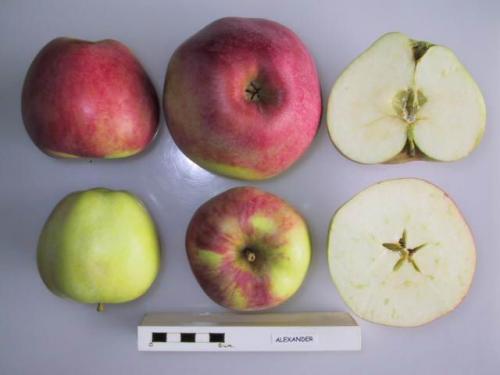
Baldwin
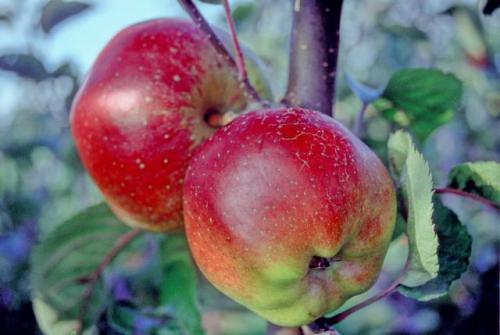
Origin – Wilmington, Massachusetts, USA (~1740)
Introduced – ~1780
Description – Medium-large, fruit of variable shape. The relatively thick skin is usually a red or green colour, with a striped pattern. They have a coarse-textured, yellowish flesh.
Tasting Notes – Crisp, sweet, aromatic, juicy.
Uses – Excellent for use in cider. Also used in pies, where it holds its shape when cooked and provides a moderate sweetness.
Season – Late Season (Mid-October)
Notes – During the 19th century, the Baldwin apple became one of the most popular apple varieties in the United States, due to the great yields from the trees and hardy nature of the fruit. Unfortunately, the trees themselves were not as hardy. After a bumper crop in 1934, harsh weather impacted orchards before the trees had time to harden off for winter. Alternating periods of extreme cold and unusual warmth killed off over a million apple trees in Maine, almost two-thirds of the population. After that, wide scale production of Baldwin’s ceased. They are still grown as an heirloom variety in some orchards.
Blenheim Pippen (aka Blenheim Orange)
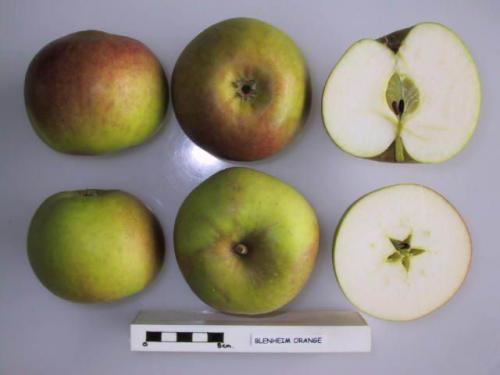
Origin – Woodstock, Oxfordshire, England (~1740)
Introduced – 1818
Description – Large, flattish fruit. Greenish-yellow skin flushed with orange-red. Flesh is coarse-textured, creamy white.
Tasting Notes – Nutty, sweet, aromatic, dry.
Uses – Though fine for fresh eating, the Blenheim pippin is best used for cooking. It does not hold its shape but creates a stiff puree as it cooks.
Season – Mid-Season (Late September)
Notes –Blenheim pippins are among the most vigorous of apples trees when it comes to growth. They can reach heights of 10 metres over forty to fifty years. Without regular attention, the trees can simply grow too high to be practical for collecting fruit.
Bourassa
Origin – Unknown. Possibly France or Quebec. (Before 1750)
Introduced – ~1750, probably earlier
Description – Variably medium to large fruit on the same tree. A gray-red to orange or reddish russet over a yellow to orange background. The flesh is tender and white.
Tasting Notes – Rich, spicy, acid, aromatic, slightly dry.
Uses – Fresh eating. Cooking.
Season – Late Season (Late October to December)
Notes – The Bourassa had become a mystery in the field of pomology. From the 18th century until the advent of the 20th century, it was noted as a popular and widely cultivated variety with a unique flavour, strong yields, and a hardiness suited to northern climates. For reasons that remain to be discovered, the Bourassa fell out of favour and stopped being planted in commercial orchards. Until recently, the variety could not be found anywhere. An effort by fruit explorer Regina Grabrovac led to a discovery of two old trees that may be the lost Bourassa. Genetic analysis is being conducted to determine the type of apple tree found.
Canada Reinette (aka Reinette du Canada)
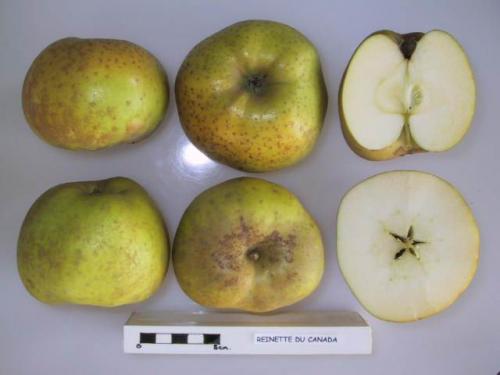
Origin – Normandy, France (Before 1771)
Introduced – 1771
Description – Large, flattish fruit. Green-yellow background colour overlaid with orange and russet. Coarse-textured, white flesh.
Tasting Notes – Sharp, tart, and crisp when picked. Sweet and dry after storage.
Uses – Cooking when newly picked. Good eating apple after some storage time.
Season – Late Season (Late September to Mid-October)
Notes – A popular variety in France, where they are referred to as “Canada”. In 1901, the variety won an Award of Merit from the Royal Horticultural Society.
Early Bough (aka Sweet Bough)
Origin – New Jersey, USA (Before 1800)
Introduced – 1817
Description – Medium to large round fruit. Thin, smooth skin with green to yellow colouration sometimes blushed with red on sun-exposed side. White, tender flesh.
Tasting Notes – Juicy, crisp, very sweet, honeyed.
Uses – Excellent as a fresh eating apple. Not preferred for cooking but serves well enough for that purpose.
Season – Early Season (Late July to August)
Notes – An old-time variety that is virtually unknown today. This early harvest apple is of outstanding quality for eating fresh but can be bitter if picked too early. It does not store well, losing flavour and texture in a matter of weeks.
Early Harvest
Origin – Long Island, NY, USA (~1700s)
Introduced – 1806
Description – Small to medium-sized flat fruit. Smooth, glossy skin with a pale green colour sometimes blushed with orange. White, tender flesh.
Tasting Notes – Tangy, crisp, acid, juicy.
Uses – Fresh eating when allowed to ripen. Used in cooking when underripe, particularly for apple sauce.
Season – Early Season (Late July to September)
Notes – N/A
Emperor Alexander (aka Alexander)
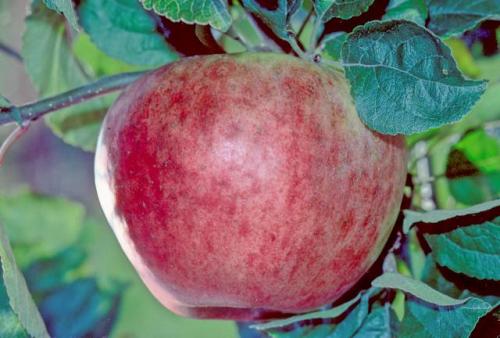
Origin – Ukraine (~1700s)
Introduced – 1805
Description – Very large, round fruit. Background colour of a pale greenish-yellow flushed with bright red. Thick, smooth skin covers a white flesh with a tinge of yellow.
Tasting Notes – Juicy, acid, sharp, sweet if eaten fresh.
Uses – Fresh eating right off the tree. Otherwise preferred for cooking. Makes an apple sauce with lemony undertones.
Season – Mid-Season (Mid-September to Early October)
Notes – Thought to have originally been called an Aporta. It was renamed by nurseryman James Lee Jr. of Hammersmith in honour of the Russian Emperor Alexander I when it came to the UK market in 1805. It has over 83 synonyms referring to the same variety.
Esopus Spitzenburg
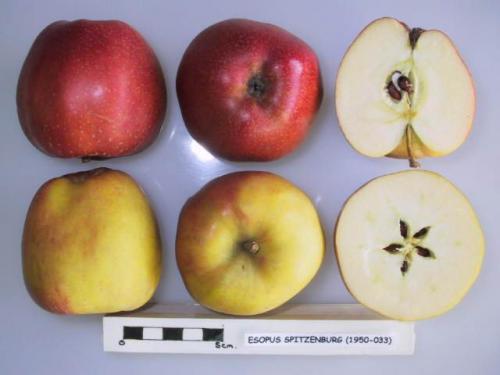
Origin – Hudson River Valley, NY, USA (~1700s)
Introduced – ~1790
Description – Medium sized fruit, variable in shape. A yellow background brightly flushed with red and dotted with russet. The skin is tough and waxy. Flesh is a creamy yellowish colour.
Tasting Notes – Complex, sweet-tart, aromatic, peach, citrus, juicy, spicy
Uses – Its complex flavour profile makes it exceptional for fresh eating. Also noted to be excellent for cooking, drying, and ciders.
Season – Mid-Late Season (Early to Mid October)
Notes – It is said that the Esopus Spitzenburg gained popularity after Thomas Jefferson ordered twelve trees for his orchard in 1790. Despite its recognition as one of the best quality varieties for multiple purposes, it fell out of popularity with commercial orchardists due to relatively small yields, specific growing conditions, and susceptibility to disease. It remains a popular choice among enthusiasts and can still be found growing in select orchards in Europe and North America.
Fameuse (aka Snow Apple)
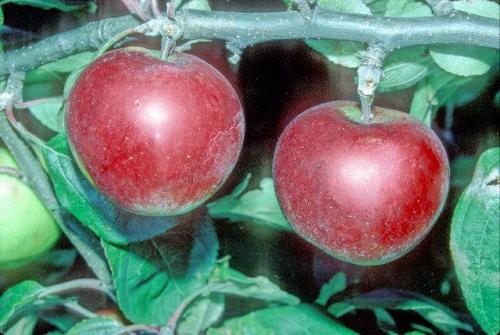
Origin – Quebec, Canada or France (Before 1700s)
Introduced – Early 1700s
Description – Small to medium fruit, flat to round in shape. Glossy skin with a pale-yellow background almost entirely covered with a bright red blush. Soft white flesh sometimes streaked with red under the skin.
Tasting Notes – Juicy, melting, very sweet, tangy, strawberry
Uses – Excellent for fresh eating, cooking, and cider.
Season – Mid-Season (Late September)
Notes – One of North Americas oldest apple varieties, it was planted extensively by French settlers in the 1700s and likely originated from seed brought from France. By the start of the French-Indian War in 1754, most homesteads around Lake Champlain would have hosted orchards of Fameuse. In the late 1800s, many Fameuse trees in the growing region of modern-day Quebec and Vermont were killed by extreme cold, disease, or both and their popularity waned. The more familiar McIntosh is thought to be descended from Fameuse, inheriting some of its good flavour along with a hardiness its forebear did not possess.
Gilliflower (aka Cornish Gilliflower)
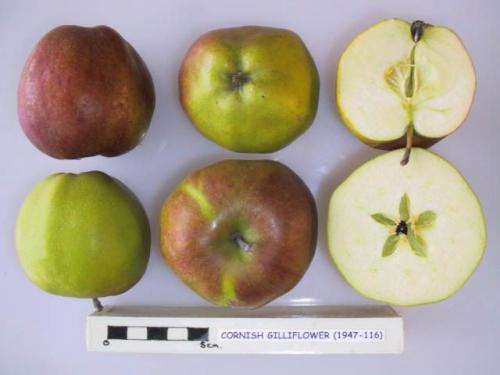
Origin – Truro, Cornwall, England (~1800)
Introduced – 1813
Description – Medium-large fruit with a conical shape. Greenish-yellow background with red blush on the sun-exposed side. Tender, white flesh.
Tasting Notes – Juicy, sweet, rich, aromatic, flowery
Uses – Mainly used for fresh eating but serves well for cooking.
Season – Mid-Season (Late September to Early October)
Notes – An extremely popular variety in Victorian England, there are contrasting stories about the origin of its name. The word gilliflower may be an anglicization of the French word “girofle”, meaning clove. Depending on who is asked, it could be attributed to the clove-like scent produced by its flowers or the odour emitted when the fruit is cut.
Gloria Mundi
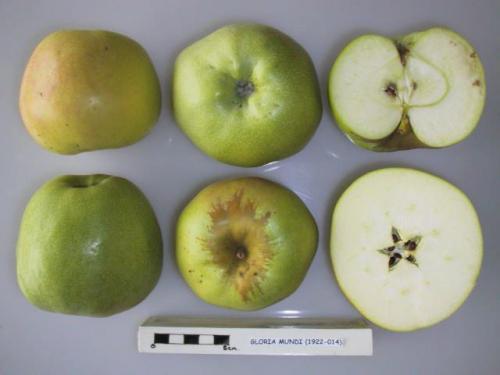
Origin – USA or Germany (Before 1800)
Introduced – 1804
Description – Very large, round fruit with irregular shape. Pale green skin sometime flushed light brown on sun exposed side. Creamy white, coarse-textured, flesh with slight green colour under the skin.
Tasting Notes – Dry, tart, acid, sweetens with cooking or storage
Uses – Cooking, cider
Season – Mid to Late Season (Early to Mid-October)
Notes – Produce very large fruit. One apple weighed in at 3.5 lbs in 1860! Despite its lacklustre flavour, its prodigious size and ability to sweeten into a dark gold puree with cooking make it a good option for pies and sauces.
Golden Pippin
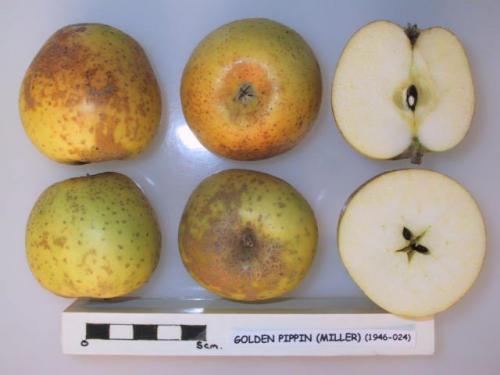
Origin – England (Before 1600s)
Introduced – 1629
Description – Small to medium fruit with a conical shape. Golden yellow skin with patches of russeting. Firm, yellow flesh.
Tasting Notes – Sharp, crisp, rich, very juicy, sweet, lemon, tangy
Uses – Fresh eating, cider, firm flesh holds shape well for cooking
Season – Mid to Late Season (Early to Mid-October)
Notes – Widely grown in English orchards and gardens in the 1800s but failed to flourish in North America. Two other varieties, the Fall Pippin and Ortley, used the name Golden Pippen as a synonym, despite coming from different parentage. It is difficult to say for certain which variety was brought to Nova Scotia by Charles Prescott.
Gravenstein
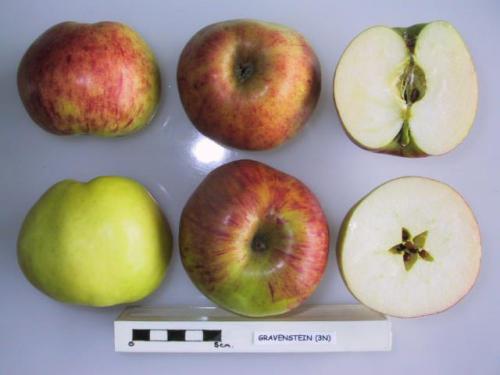
Origin – Italy or Denmark (1600s)
Introduced – 1797
Description – Medium to large fruit, oblong and irregular in shape. Has a waxy skin with a background of green to bright yellow covered with red stripes and blush. Tender, yellowish flesh.
Tasting Notes – Sweet, tart, balanced, savoury, spice, acid
Uses – Fresh eating, cooking, cider, juice
Season – Mid-Season (Early to Mid-September)
Notes – The most prolific of the apple varieties Charles Prescott introduced to Nova Scotia, Gravenstein apples are still a popular choice in the province today. Since they don’t keep well and can only be bought in season, they have come to be a sure sign of Autumn and end up in countless apple pies and crisps. That short shelf-life also means that, while Gravensteins remain popular in Nova Scotia and other regions where they are grown, they are not well known in many parts of the world. It was declared the national apple of Denmark in 2005.
Keswick Codlin
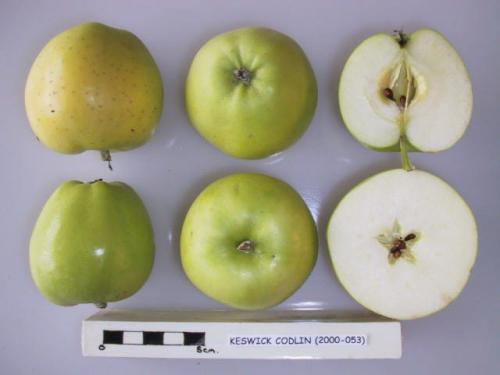
Origin – Gleaston Castle, Lancashire, England (1793)
Introduced – Early 1800s
Description – Medium-large fruit, round to oblong in shape. Greenish-yellow skin with a golden-orange blush on sun-exposed side. Tender, creamy-white flesh.
Tasting Notes – Very juicy, acid, somewhat sweet, sharp, tart
Uses – Excellent for cooking, good for fresh eating if allowed to ripen completely
Season – Early Season (Mid to Late August)
Notes – Received its name from nurseryman John Sander of Keswick, who propagated the variety from cuttings of the tree discovered at Gleaston Castle.
King of Pippin (aka King of the Pippins)

Origin – Normandy, France (1500s)
Introduced – 1800
Description – Small, round to oblong fruit. Skin has a yellow background with reddish-orange blush and red stripes. Firm flesh with an off-white colour.
Tasting Notes – Crisp, juicy, sweet, tart, balanced, almond
Uses – Fresh eating, cooking, cider
Season – Mid to Late Season (Early to Mid-October)
Notes – This heirloom variety was being cultivated and consumed for a long time in France before being officially recorded as “King of the Pippins”. It’s original name is thought to have been Reine des Reinettes, but another variety of Dutch origin currently carries that name and is a distinct variety which causes some confusion.
Liscomb (aka Lyscom)
Origin – Southborough, Massachusetts, USA
Introduced – Early 1700s
Description – Large to very large, round fruit. Greenish-yellow background with red streaks. Coarse-textured, yellow flesh.
Tasting Notes – Slightly sweet, tart, astringent, balanced, pear, lemon, spice
Uses – Fresh eating, cooking
Season – Mid to Late Season (Late September to November)
Notes – Little is recorded about this apple variety. It is thought to have been first discovered and propagated by Samual Lyscom on his family farm in the 1700s. From there, the variety was spread further abroad. It was last recorded growing in Southborough in 1917. A depression era program sough to eradicate wild apple trees under the assumption they could introduce disease to commercial orchards, leading to the demise of many heirloom trees. Due to the efforts of enthusiasts in the 1950s some old varieties were rescued, including the lyscom. In 1973 the last known lyscom tree was identified growing in the Preservation Orchard that housed those old varieties. Members of the Southborough Historical Society harvested 32 scions to grow throughout the town in celebration of its 250th anniversary. Unfortunately, over the years almost every tree succumbed to decay, disease, or development. Currently only one survives. Efforts are underway to spread the lyscom apple tree throughout the town once again with the hope of its preservation.
Northern Spy
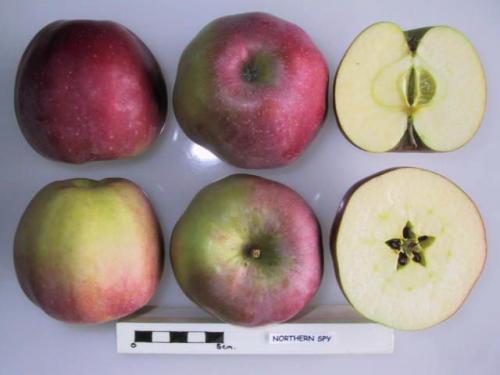
Origin – Connecticut, USA (before 1800)
Introduced – 1840
Description – Large, round fruit, slightly conical. Thin skin with a background of green and flushes of red to orange. White, firm flesh.
Tasting Notes – Juicy, moderately sweet, tart, honey
Uses – Fresh eating, cooking, cider, juice
Season – Late Season (Mid-October to November)
Notes – This variety is well suited to winter storage, lasting well into the spring and beyond with refrigeration. It is also noted for being very high in antioxidants, providing additional health benefits.
Pomme Gris
Origin – Continental Europe or Quebec, Canada (~1600s)
Introduced – 1803
Description – Small to medium fruit, round to somewhat flattened. Thick skin is a greenish-yellow mostly covered by brown russet, sometimes with a pink blush. Firm, slightly coarse, creamy yellow flesh.
Tasting Notes – Juicy, aromatic, sweet, nutty, pear, vanilla
Uses – Fresh eating, cider
Season – Mid to Late Season (Late September to Mid-October)
Notes – The origins of this variety are not clear, although it is widely believed to have originated in France and was brought to Quebec by French or Swiss settlers. The defined brown russet covering the skin is opposed to what most people think of when bring apples to mind. Despite its somewhat unattractive exterior, it is of excellent quality for fresh eating.
Rhode Island Greening
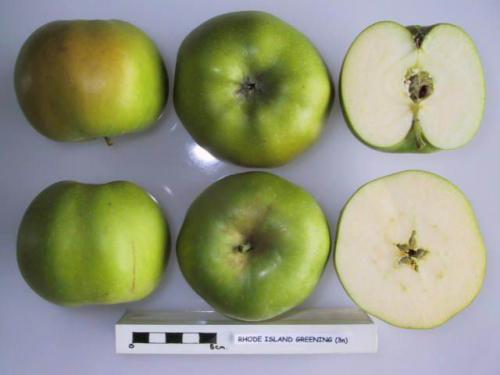
Origin – Green’s End, Rhode Island, USA (1600s)
Introduced – 1640s
Description – Large round fruit. Thick skin that is green to yellow in colour, sometimes flushed with orange on the sun exposed side. Fine-grained, white flesh is greenish-yellow just under the skin.
Tasting Notes – Crisp, juicy, tart, sharp, acid, mildly sweet
Uses – Cooking, drying
Season – Late season (Mid-October to November)
Notes – First recorded as being grown in Newport by a tavernkeeper, the cuttings were routinely handed out to patrons to start their own tree. The original tree was used for these cuttings so often that it eventually died from the stress of constant healing. This old variety continues to be a commercially successful product even after hundreds of years of cultivation. That could be attributed to the fact that it is a popular choice for making apple pies in the US, where the preference is generally for the fruit to maintain its shape and some texture after cooking.
Ribston Pippin
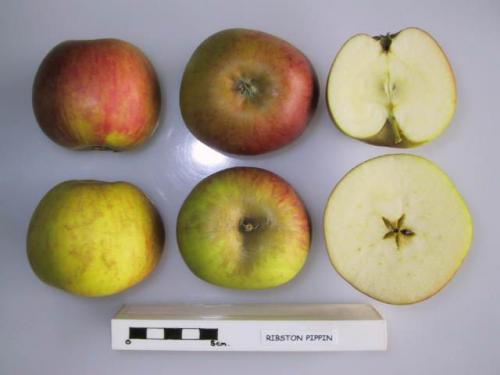
Origin – Ribston Hall, Yorkshire, England (1707)
Introduced – 1769
Description – Medium to large, round fruit. Skin has a background of greenish-yellow with orange flushes, red stripes, and some russeting around the stem. Fine-grained, cream coloured flesh.
Tasting Notes – Juicy, sweet, pear, aromatic
Uses – Fresh eating, cooking, cider, juice
Season – Mid-Season (Mid to Late September)
Notes – The most popular apple in Victorian England, Ribston Pippins were esteemed for their strong flavour and juiciness. It was superseded by its progeny, the Cox’s Orange Pippin, in the 1800s but remains a popular variety in many UK gardens.
Spitzenburg (see Esopus Spitzenburg)
St Lawrence (aka Saint Lawrence)
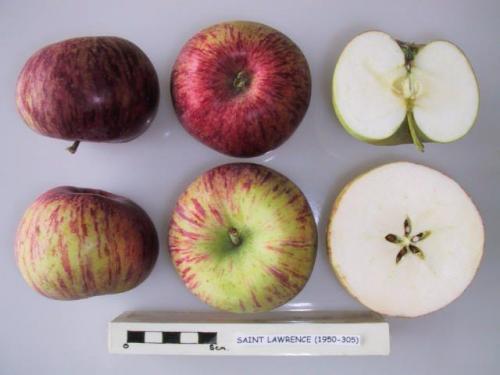
Origin – Montreal, Quebec, Canada (1700s)
Introduced – Early 1800s
Description – Medium-large, variable shaped fruit. Pale yellow skin covered in bright red and darker red stripes. Flesh is white with red stain under the skin.
Tasting Notes – Juicy, mild, sweet, acid
Uses – Fresh eating, cooking
Season – Mid-season (Mid to Late September)
Notes – Widely grown in Quebec in the mid 1800s. As other varieties became available this heirloom fruit fell out of favour and is rarely found, or even known of, today.
Sweeney Nonpareil
Origin – Shropshire, England (early 1800s)
Introduced – 1820
Description – Medium to large, round, conical fruit. Skin is glossy green colour with thick patches of russet, sometime flushed brown on the sun exposed side. Flesh is a greenish white.
Tasting Notes – Sweet, mildly tart, flavourful
Uses – Cooking
Season – Unknown
Notes – Very little is written on this variety.
Sweet Bough (See Early Bough)
Tolman Sweet
Origin – Massachusetts or New York, USA (~ Late 1700s)
Introduced – 1822
Description – Medium, round to conic fruit. Skin is pale-yellow with red blush on sun exposed side and slight russeting. Flesh is fine-grained and white.
Tasting Notes – Dry to moderately juicy, very sweet
Uses – Fresh eating, cooking, drying, cider
Season – Mid-season (Mid to Late September)
Notes – There is no agreement on where this variety first began, with claims coming from both Dorchester, Massachusetts and Geneva, New York. Its early popularity was helped by its good yields and versatility of uses.
Sources
Borrie, Richard & Chaussee, Scott. Orange Pippin: All About Apples, Pears, Plums, and Cherries – and Orchards Where They Are Grown, 2019, https://www.orangepippin.com/varieties/apples.
Gruenfeld, George. Pomiferous, https://pomiferous.com/
National Fruit Catalogue. University of Reading, 2019, http://www.nationalfruitcollection.org.uk/index.php
Salt Spring Apple Co. Orchard and Nursery: Varieties, 2020, https://www.saltspringapplecompany.com/orchard/#our-varieties
Images
National Fruit Catalogue. University of Reading, 2019, http://www.nationalfruitcollection.org.uk/index.php
Open Government Licence with Attribution http://www.nationalarchives.gov.uk/doc/open-government-licence/version/3/